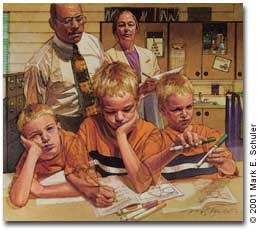
Am Fam Physician. 2001;64(8):1308

AFP has two basic kinds of editors on staff: editors with medical degrees whose primary responsibility is overseeing medical content, and professional wordsmith editors with backgrounds in English or journalism rather than medicine. The two types of editors exist symbiotically because physicians must use words to express their knowledge of medicine, and wordsmiths must understand medicine to clarify the written word. Successful editors stretch as far as they can toward understanding the other discipline.
Becoming an editor for AFP requires tenacity for both the physicians and the wordsmiths. Physicians working on AFP must have an interest in words, and professional editors must have an interest in medicine. Learning the opposite discipline can be a challenge, and the combination isn't for everyone. AFP is a unique journal in that it provides clinical recommendations synthesized from the best available evidence rather than serving as a means of disseminating raw research findings. As CME offerings, AFP's clinical reviews are intended to be read rather than stored and, as such, are meticulously edited rather than poured into a mold. AFP's editors don't come from a mold, either. Most of them are homegrown.
How does AFP grow its editors? One inch at a time. For physician editors, the road usually starts out with training in clinical medicine and work in academic medicine. Physician editors are natural teachers. They may start out by teaching students and working on their own research projects and writing. Those who want more in this direction may become a journal editor. Physician editors learn the trade through apprenticeship with other physician editors, often through the editor's medical editing clerkship and fellowship programs.
For many wordsmith editors, the love of the written word comes first, and the love of medicine grows after seeds of curiosity take root. Finding the right wordsmith editor begins with screening applicants with various writing and editing backgrounds. Potential candidates go through screening tests and interviews. Although we don't exactly go out of our way to create a difficult entrance examination, we have learned that our basic editing test stumps unprepared candidates, and many abort the test halfway through. Once a tentative match is found, editors begin the true trial period.
For wordsmiths, learning how to edit clinical topics in medicine is done through an intensive apprenticeship that requires a high degree of motivation. Learning the discipline of medical editing entails learning medical terminology, getting a grasp on medical style as set forth in the AMA Manual of Style and other guides, and gaining a general working knowledge of the field of medicine. Editors seeking instant gratification undoubtedly fail. Successful wordsmith editors are those who love challenge and live the mission of the journal. Some editors go on to earn credentials from the Board of Editors in the Life Sciences (BELS).
In today's workplace, hard work and delayed gratification seem like old-fashioned virtues, but for our physician editors and wordsmith editors, the reward is producing 24 issues of AFP per year with the goal of boosting the ability of family physicians to care for their patients. How are we doing?